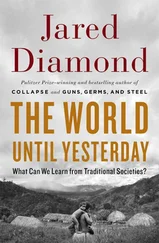Jared Diamond - Guns, Germs & Steel
Здесь есть возможность читать онлайн «Jared Diamond - Guns, Germs & Steel» весь текст электронной книги совершенно бесплатно (целиком полную версию без сокращений). В некоторых случаях можно слушать аудио, скачать через торрент в формате fb2 и присутствует краткое содержание. Жанр: 105. Описание произведения, (предисловие) а так же отзывы посетителей доступны на портале библиотеки ЛибКат.
- Название:Guns, Germs & Steel
- Автор:
- Жанр:
- Год:неизвестен
- ISBN:нет данных
- Рейтинг книги:5 / 5. Голосов: 1
-
Избранное:Добавить в избранное
- Отзывы:
-
Ваша оценка:
- 100
- 1
- 2
- 3
- 4
- 5
Guns, Germs & Steel: краткое содержание, описание и аннотация
Предлагаем к чтению аннотацию, описание, краткое содержание или предисловие (зависит от того, что написал сам автор книги «Guns, Germs & Steel»). Если вы не нашли необходимую информацию о книге — напишите в комментариях, мы постараемся отыскать её.
Guns, Germs & Steel — читать онлайн бесплатно полную книгу (весь текст) целиком
Ниже представлен текст книги, разбитый по страницам. Система сохранения места последней прочитанной страницы, позволяет с удобством читать онлайн бесплатно книгу «Guns, Germs & Steel», без необходимости каждый раз заново искать на чём Вы остановились. Поставьте закладку, и сможете в любой момент перейти на страницу, на которой закончили чтение.
Интервал:
Закладка:
158 • GUNS, GERMS, AND STEEL
plant species seemingly suitable for domestication were never domesticated, we shall now tackle the corresponding question for domestic mammals. Our former question about apples or Indians becomes a question of zebras or Africans.
inchapter 4 we reminded ourselves of the many ways in which big domestic mammals were crucial to those human societies possessing them. Most notably, they provided meat, milk products, fertilizer, land transport, leather, military assault vehicles, plow traction, and wool, as well as germs that killed previously unexposed peoples.
In addition, of course, small domestic mammals and domestic birds and insects have also been useful to humans. Many birds were domesticated for meat, eggs, and feathers: the chicken in China, various duck and goose species in parts of Eurasia, turkeys in Mesoamerica, guinea fowl in Africa, and the Muscovy duck in South America. Wolves were domesticated in Eurasia and North America to become our dogs used as hunting companions, sentinels, pets, and, in some societies, food. Rodents and other small mammals domesticated for food included the rabbit in Europe, the guinea pig in the Andes, a giant rat in West Africa, and possibly a rodent called the hutia on Caribbean islands. Ferrets were domesticated in Europe to hunt rabbits, and cats were domesticated in North Africa and Southwest Asia to hunt rodent pests. Small mammals domesticated as recently as the 19th and 20th centuries include foxes, mink, and chinchillas grown for fur and hamsters kept as pets. Even some insects have been domesticated, notably Eurasia's honeybee and China's silkworm moth, kept for honey and silk, respectively.
Many of these small animals thus yielded food, clothing, or warmth. But none of them pulled plows or wagons, none bore riders, none except dogs pulled sleds or became war machines, and none of them have been as important for food as have big domestic mammals. Hence the rest of this chapter will confine itself to the big mammals.
1 he importance of domesticated mammals rests on surprisingly few species of big terrestrial herbivores. (Only terrestrial mammals have been domesticated, for the obvious reason that aquatic mammals were difficult to maintain and breed until the development of modern Sea World facili-
ZEBRAS AND UNHAPPY MARRIAGES • 159
• s ) If one defines "big" as "weighing over 100 pounds," then only 14 ch species were domesticated before the twentieth century (see Table 9.1 f r a list). Of those Ancient Fourteen, 9 (the "Minor Nine" of Table 9.1) became important livestock for people in only limited areas of the globe: the Arabian camel, Bactrian camel, llama / alpaca (distinct breeds of the same ancestral species), donkey, reindeer, water buffalo, yak, banteng, and gaur. Only 5 species became widespread and important around the world. Those Major Five of mammal domestication are the cow, sheep, goat, pig,
and horse.
This list may at first seem to have glaring omissions. What about the African elephants with which Hannibal's armies crossed the Alps? What about the Asian elephants still used as work animals in Southeast Asia today? No, I didn't forget them, and that raises an important distinction. Elephants have been tamed, but never domesticated. Hannibal's elephants were, and Asian work elephants are, just wild elephants that were captured and tamed; they were not bred in captivity. In contrast, a domesticated animal is defined as an animal selectively bred in captivity and thereby modified from its wild ancestors, for use by humans who control the animal's breeding and food supply.
That is, domestication involves wild animals' being transformed into something more useful to humans. Truly domesticated animals differ in various ways from their wild ancestors. These differences result from two processes: human selection of those individual animals more useful to humans than other individuals of the same species, and automatic evolutionary responses of animals to the altered forces of natural selection operating in human environments as compared with wild environments. We already saw in Chapter 7 that all of these statements also apply to plant domestication.
The ways in which domesticated animals have diverged from their wild ancestors include the following. Many species changed in size: cows, pigs, and sheep became smaller under domestication, while guinea pigs became larger. Sheep and alpacas were selected for retention of wool and reduction or loss of hair, while cows have been selected for high milk yields. Several species of domestic animals have smaller brains and less developed sense organs than their wild ancestors, because they no longer need the igger brains and more developed sense organs on which their ancestors depended to escape from wild predators.
o appreciate the changes that developed under domestication, just
I 6 O • GUNS, GERMS,and steel
table 9.1 The Ancient Fourteen Species of Big Herbivorous Domestic Mammals
The Major Five
1. Sheep. Wild ancestor: the Asiatic mouflon sheep of West and Central Asia. Now worldwide.
2. Goat. Wild ancestor: the bezoar goat of West Asia. Now worldwide.
3. Cow, alias ox or cattle. Wild ancestor: the now extinct aurochs, formerly distributed over Eurasia and North Africa. Now worldwide.
4. Pig. Wild ancestor: the wild boar, distributed over Eurasia and North Africa. Now worldwide. Actually an omnivore (regularly eats both animal and plant food), whereas the other 13 of the Ancient Fourteen are more strictly herbivores.
5. Horse. Wild ancestor: now extinct wild horses of southern Russia; a different subspecies of the same species survived in the wild to modern times as Przewalski's horse of Mongolia. Now worldwide.
The Minor Nine
6. Arabian (one-humped) camel. Wild ancestor: now extinct, formerly lived in Arabia and adjacent areas. Still largely restricted to Arabia and northern Africa, though feral in Australia.
7. Bactrian (two-humped) camel: Wild ancestor: now extinct, lived in Central Asia. Still largely confined to Central Asia.
8. Llama and alpaca. These appear to be well-differentiated breeds of the same species, rather than different species. Wild ancestor: the guanaco of the Andes. Still largely confined to the Andes, although some are bred as pack animals in North America.
9. Donkey. Wild ancestor: the African wild ass of North Africa and formerly perhaps the adjacent area of Southwest Asia. Originally confined as a domestic animal to North Africa and western Eurasia, more recently also used elsewhere.
10. Reindeer. Wild ancestor: the reindeer of northern Eurasia. Still largely confined as a domestic animal to that area, though now some are also used in Alaska.
11. Water buffalo. Wild ancestor lives in Southeast Asia. Still used as a domestic animal mainly in that area, though many are also used in Brazil and others have escaped to the wild in Australia and other places.
ZEBRAS AND UNHAPPY MARRIAGES • I 6 I
12 Yak. Wild ancestor: the wild yak of the Himalayas and Tibetan plateau Still confined as a domestic animal to that area.
13 Bali cattle. Wild ancestor: the banteng (a relative of the aurochs) of Southeast Asia. Still confined as a domestic animal to that area.
14 Mithan. Wild ancestor: the gaur (another relative of the aurochs) of Indian and Burma. Still confined as a domestic animal to that area.
compare wolves, the wild ancestors of domestic dogs, with the many breeds of dogs. Some dogs are much bigger than wolves (Great Danes), while others are much smaller (Pekingese). Some are slimmer and built for racing (greyhounds), while others are short-legged and useless for racing (dachshunds). They vary enormously in hair form and color, and some are even hairless. Polynesians and Aztecs developed dog breeds specifically raised for food. Comparing a dachshund with a wolf, you wouldn't even suspect that the former had been derived from the latter if you didn't already know it.
The wild ancestors of the Ancient Fourteen were spread unevenly over the globe. South America had only one such ancestor, which gave rise to the llama and alpaca. North America, Australia, and sub-Saharan Africa had none at all. The lack of domestic mammals indigenous to sub-Saharan Africa is especially astonishing, since a main reason why tourists visit Africa today is to see its abundant and diverse wild mammals. In contrast, the wild ancestors of 13 of the Ancient Fourteen (including all of the Major Five) were confined to Eurasia. (As elsewhere in this book, my use of the term "Eurasia" includes in several cases North Africa, which biogeographically and in many aspects of human culture is more closely related to Eurasia than to sub-Saharan Africa.)
Of course, not all 13 of these wild ancestral species occurred together throughout Eurasia. No area had all 13, and some of the wild ancestors were quite local, such as the yak, confined in the wild to Tibet and adjacent highland areas. However, many parts of Eurasia did have quite a few of these 13 species living together in the same area: for example, seven of the wild ancestors occurred in Southwest Asia.
A very unequal distribution of wild ancestral species among the con-
Интервал:
Закладка:
Похожие книги на «Guns, Germs & Steel»
Представляем Вашему вниманию похожие книги на «Guns, Germs & Steel» списком для выбора. Мы отобрали схожую по названию и смыслу литературу в надежде предоставить читателям больше вариантов отыскать новые, интересные, ещё непрочитанные произведения.
Обсуждение, отзывы о книге «Guns, Germs & Steel» и просто собственные мнения читателей. Оставьте ваши комментарии, напишите, что Вы думаете о произведении, его смысле или главных героях. Укажите что конкретно понравилось, а что нет, и почему Вы так считаете.










